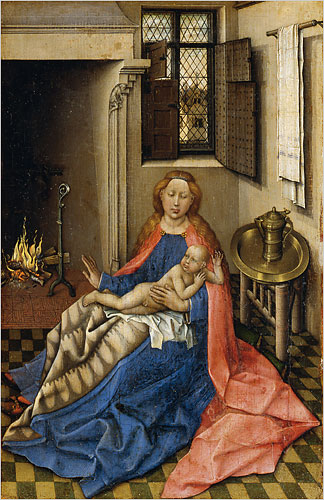
Oil on Canvas – In the State Heritage museum in St. Petersburg, Russia. No date of painting given.
As V &B Mettlach beer stein collectors most always collect a few Mettlach incised (not etched!) plaques to go with their collection, and as “Reservist” beer stein collectors also display Reservist certificates or unit photographs, then so might a metal arts stein collector save these brass and pewter “Go Withs.”
.
“ALMS DISHES AND BOWLS” (“ROSEWATER BOWLS” ****) – MADE IN NURNBURG IN THE 1400’s THROUGH THE 1600’s:
Several years ago I was fortunate to visit “The Cloisters” in New York City. This museum is one of the branches of the larger, world famous Metropolitan Museum of Art, and houses the “MET’s” medieval and early renaissance collection of art works.
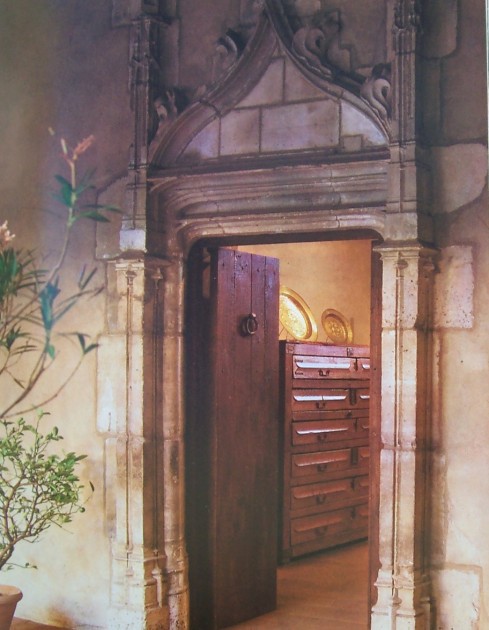
As I was walking through one room ▲, I was taken by what I found out later to be called “Alms Dishes” **** large old brass ones and shined up – I love shined brass and copper.) At that time I said to myself : “Self! – I’ll bet you can find some of these guys out there in the real world if you look long and hard enough.” (Sho nuf – did !)
Above ▲, two of several “Alms Dishes / Trays” displayed within “The Cloisters” in upper NYC, in northern Manhattan’s Fort Tyron Park.
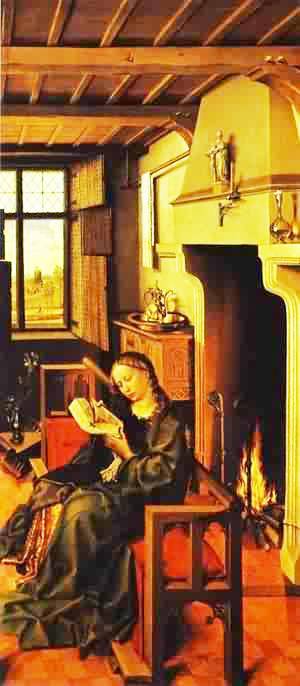
*** Rosewater bowl – A large brass dish or bowl where rose petals were crushed and thrown into the water to try to make a room smell better.
Only the rich could afford this luxury back then. (And if you have checked out the prices of a dozen roses in 2013, it still applies!!)
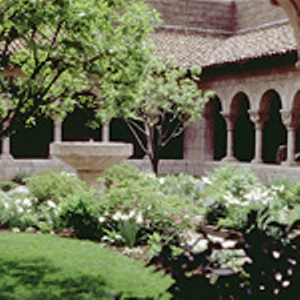
The Cloisters is devoted to the art and architecture of medieval Europe was assembled from architectural elements, both domestic and religious, that date from the twelfth through the fifteenth century. The building and its cloistered garden, located in Fort Tryon Park in northern Manhattan, are treasures in themselves, effectively part of the collection housed there.
To view fifty highlights from The Cloisters: sculpture, tapestries, illuminated manuscripts, goldsmiths’ and silversmiths’ work, stained glass, enamels, ivories, and more; See: http://www.metmuseum.org/event/ev_cloisters.asp?HomePageLink=collections_cloisters_l
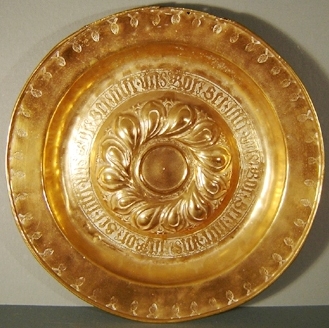
Above ▲: The style of the larger and more decorative and religious brass alms dishes/ trays from the 1500’s on into the 1600’s.
Smaller ones, mostly bowls were made earlier. I love the scene on this bowl.▼
The experts at the Museum have called this scene below: “Punishment.” But I think, yes, it could well be what you think is going on!
Oh for the good old days, hey ??
From a new dictionary: Noun [1. ] Alms tray – a tray for collecting the offering from a congregation, alms dish. They do not list the Antique version of the word which happens to be is a misnomer as these dishes / bowls and trays WERE NOT used in churchs but in the homes.
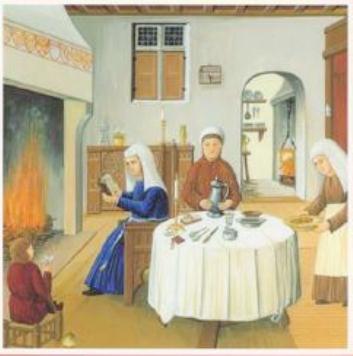
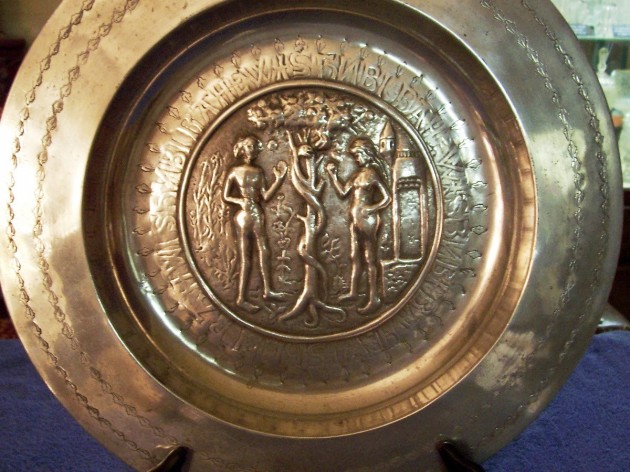
Now the European pewter-smiths back then were not to be left out of the market. However now in 2013 original pewter alms dishes are Rare-rare!! Some of the reasons being: [1] they were softer than brass and subject to more damage earlier in life. [2] the brass ones were a sign of wealth and pewter was not. Please remember 100% brass (also known as brass and /or bronze “Messing” in Germany ) was right under silver as a precious metal back in the Medieval and early Renaissance times. Shown on the 3rd photo below▼ is a 15 diam. pewter “Alms Dish”, a copy of the older style but made about the late 1800’s as is the one just above ▲. I’m hesitant to call these two “reproductions” per se as they made these for a long time but for display only, mostly on a cupboard / sifdeboard. Shown 4 photos downis another version of Adam and Eve. 16 inches, with no marks. but only Ca. 1880 I believe . [FWTD]
Ebay ad’s header read: Pewter Baptismal Font -“Lamb of God”- DTD. 1767. -Austria
( (Alms Bowl? Not deep enogh for any Font I have ever seen!! ) Starting price was $999.00! It ended with no sale – on MAY 14, 2006.)
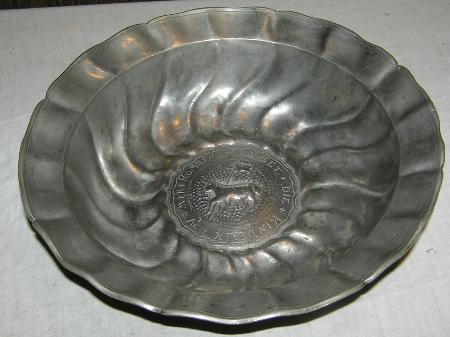
THE EBAY AD’S WRITE -UP: “You are bidding on an Antique Pewter Baptismal Font with the “Lamb of God” in relief and dedicated to the St. Margarethen Church for the Baptism of a child in 1767. This piece is among the rarest pieces of Pewter that I have ever found. This Pewter Baptismal Font was spun in the early 18th Century and dedicated to the Church of St. Margarethen in Burgenlan, Austria. The Saint was reportedly martyred at a rock Quarry by the Romans and to this day this location is honored by one of the most famous and long lasting passion play in Europe. This Baptismal Font or Bowl has the Touch of an early Austria / Swiss Master with a reported death date of 1705. The font was dedicated and formally transferred to the Church in 1767 at the birth of the female child Barbara Margaretha Ellinger. On the bottom of the Font or bowl is a beautiful representation of the “Lamb of God” holding a Banner with a Crucifix. There is a dedication in German “Zu Mir Kommen Lasset Die Kindlein”. This is apparently a regional dialect in familiar form and my poor translation is “To Me bring and leave the Children”. I have placed this Font is several area of my home and experimented with varying light. It is a spectacular piece. This Baptismal Font was acquired at an Estate Sale in Austria and it is in very good to excellent condition. There are a few very minor scratches on the underside on the bowl. This spectacular Baptismal Font can be the benchmark piece of your Pewter collection. It can also be contributed to a Church as a loving gift. The Antique Pewter Baptismal Font with the “Lamb of God” in repousse measures 13 1/4″ in. diameter and is 3 1/2″ in. height.”
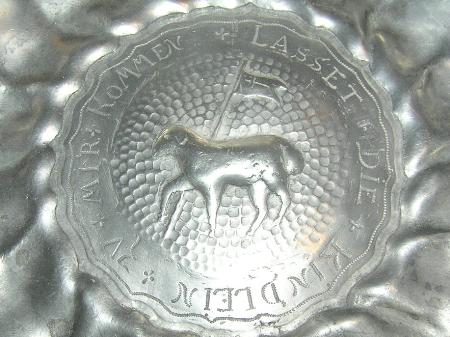
Detail of the “Lamb of God” with NO wear, shown what so ever -!!!!!
Lamb of God – An olden days Catholic symbol for Jesus.
Editor’s notes: I really think this [▲] is a reproduction! Look at both photos close up. There is no evidence of any wear! If it had been used in a church for hundreds of years as stated, it would have been beat all to hell, and had all sorts of age spots, scabs and perhaps cracks! The rear certainly would have lots of wear and a ring showing where it sat for so long in its holder, usually made of marble.(But if it is a repro then that means there should be an original out there somewhere. Anyone seen it?)
Below ▼: Another version of an Adam and Eve Alms Dish in pewter. This one is also new but might have been cast from an older one as the “wear age” of the figures certainly does look correct . See detail phototwo below ▼▼.
![11 INCH [Q] , 15-16TH ARROW POINTS TO CIRCLE OF WRITING WORN -](http://www.steveonsteins.com/wp-content/uploads/2013/05/ALMS-TRAY-ebay-11-INCH-Q-15-16TH-ARROW-POINTS-TO-CIRCLE-OF-WRITING-WORN-NO-SALE-AT-302-.00-ENGLAND-8-07.jpg)
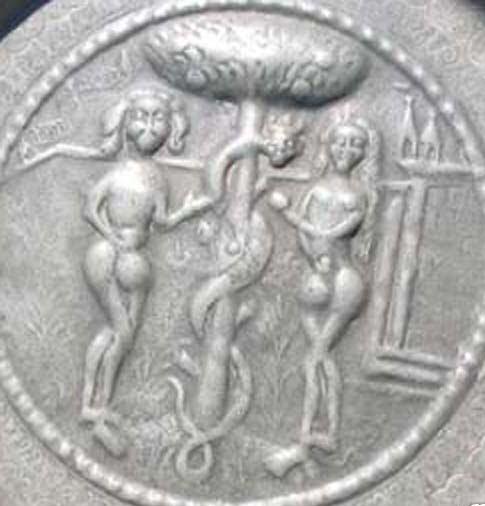
An interesting version.Those jugs are hiding their private parts (much different than the usual fig leaves !! And look at the serpent with a crown (MEANING WORLDLY GOODS =??, and a with small face. I think it is Great! – Even so .I didn’t buy it.
Another “Adam and Eve” (a very popular alms dish subject it appears) this is from France. The original ones with this style of body figures were made in the 1500’s in Malines: now a municipality in the province of Antwerp, Flanders, Belgium.
Marked “Etain,” and “95%” =
both of which indicates it is of much newer stock than what it looks like (and was being sold as on ebay! a few years back.)
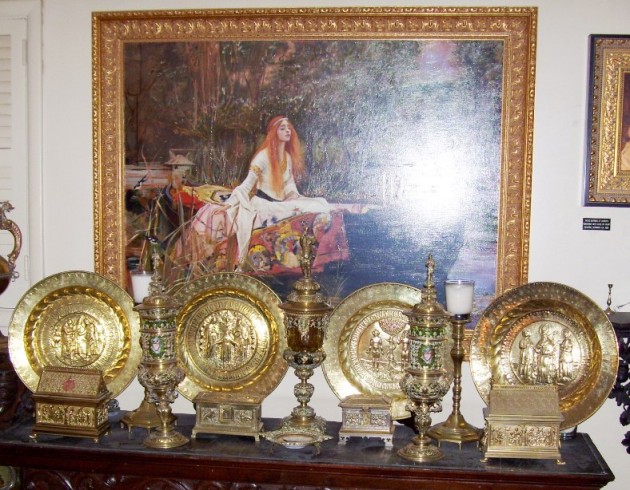
Photo of the brass Alms Dishes used as a backdrop display with three large Bronze pokals within the FWTD collection. [FWTD]
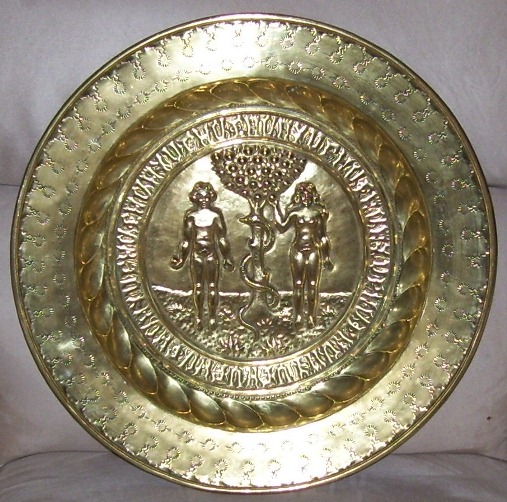
Adam and Eve and the Serpent in the tree. A later style of brass Alms Dish, still made in Nurnburg, but according to what I have read,this one is around the mid to late 1700’s and maybe even later. [FWTD]
The actual age of these doesn’t seem to matter value wise as much as the subject matter scenes. Instead of the relatively lobed and Latin words mid section of the older ones, these are much more attractive and they still command a hefty price for a small piece of brass.
*** ▼ ▼ Additional photos of alms dishes made after the medieval period, but highly collectable today – very similar to what has happened to the late 1800’s reproductions of the “Creusen Apostle” steins from the 1600’s, as shown just below ▼.
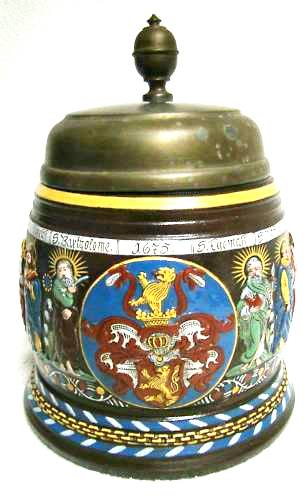
Apostle steins (Apostelkrug) [ See Compendium entry] – Early pottery steins made in and around Kreussen (also Cruessen), Germany, in the mid to late 1600′s. The relief and enameled figures celebrated the 12 Apostles and Jesus. Highly collectable and very, very reproduced over these many years. The one shown above is an excellent reproduction , made by the A Saltzer firm, (See Compendium entry) well known for their artistry on steins purchased from other companies. Some of his reproduction Apostlekrugs have sold for close to $1k. , others do not command near that much. [FWTD]
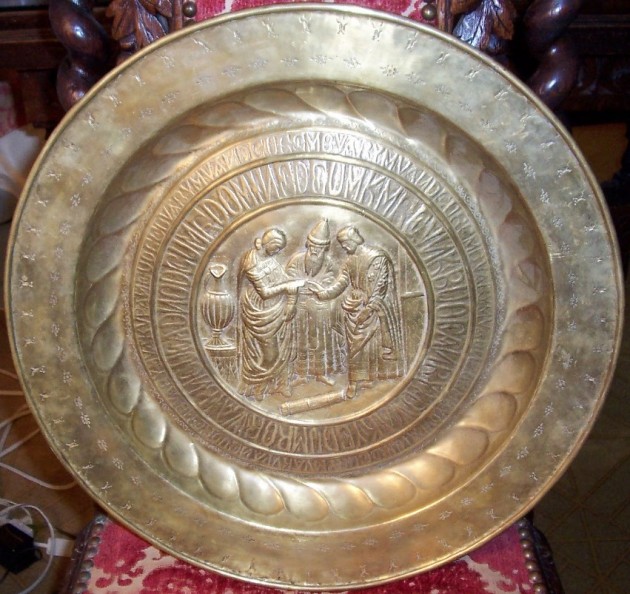
The scene shows Mary and Joseph getting married.[FWTD]
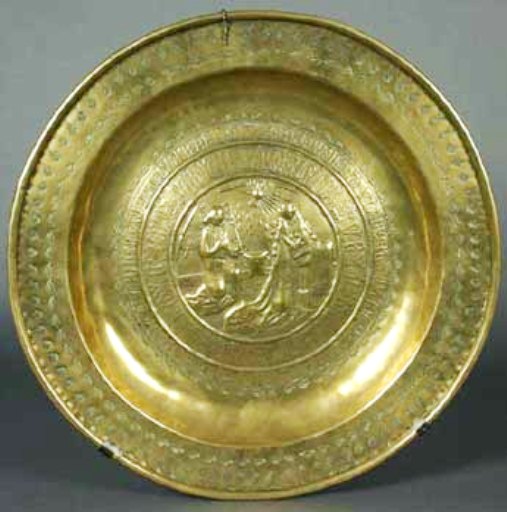
The Annunciation – 19 INCH. This scene has been seen on older pieces. [FWTD]
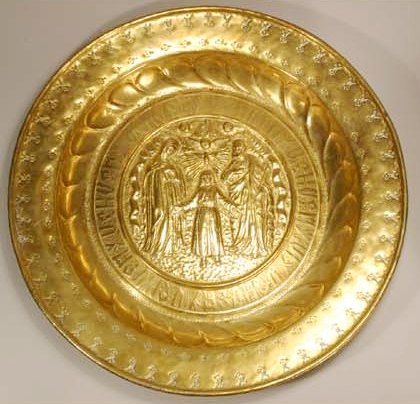
If you are a Christian then this “Alms dish” ” is “The Holy Family” = “Jesus, Mary and Joseph!” [FWTD](which to those outside the USA; is also an expression of surprise or amazement, when said with loudness. !! )
OTHER TYPES OF GO-WITH FOR A METAL ARTS COLLECTION:
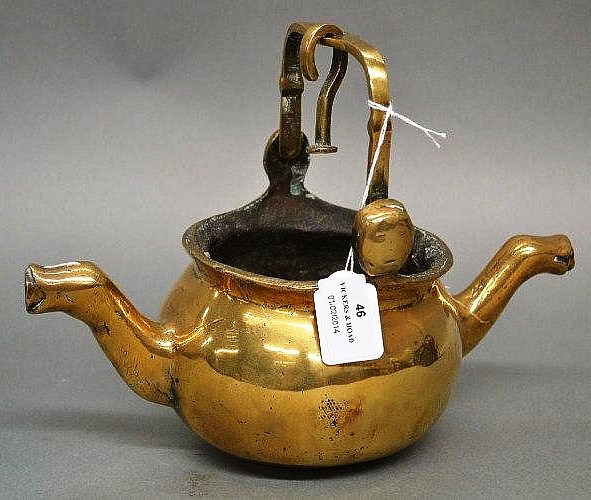
A BRONZE-HANGING WATER-WINE DISPENSER CA, 15TH – 16TH CENTURY [FWTD]
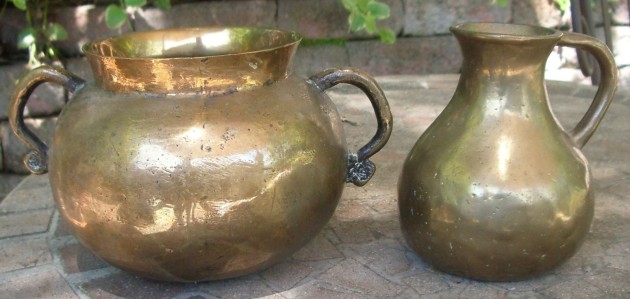
A pair of Renaiassance bronze drinking vessels. Acquired off eBay for hardly any money in spring of 2014. [FWTD]
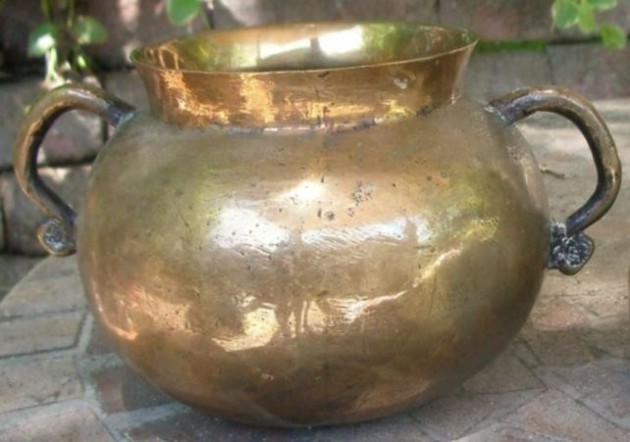
Details of Renaissance bronze “pass” drinking bowl; handles much oxidized and not much cleaned. The piece is Ca. 1500. See similarities in style / design to BRONZE HANGING WATER /WINE DISPENSER, in the just above photos.
DUTCH – BELGIUM BRASS DRINKING WALL TRAYS
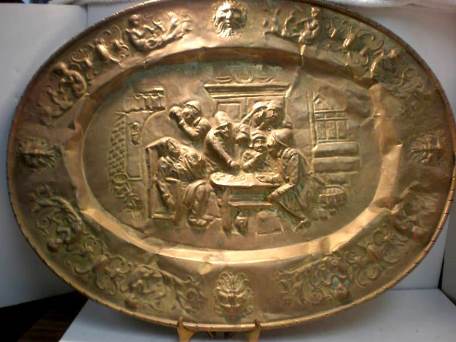
GO WITH – BRASS DUTCH WALL PLAQUE DUTCH CA. 1850 TO 1880. – SIZE 21.5 INCHES BY 11,5
The collecting of the antique brass alms trays (talked about above,) actually got me started in looking for other dust collectors to help fill my available wall space in the house . It wasn’t long before I was “INTO” large oval stamped brass display plaques / wall trays with medium relief drinking scenes These were made mostly in what is now Belgium or the lower Netherlands.
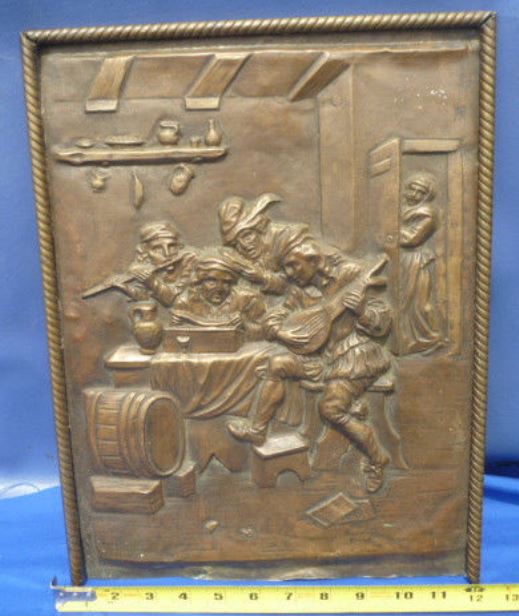
Above ▲ A Dutch relief stamped brass fire screen just like the wall trays!
All were about ca 1850 to 1880 [plus or minus a few.] . A few circular copper ones were produced several decades earlier these are hard to find. Many also show fights starting between the drinkers and card players at the keller (pub). The English firms like “Peeragee” started producing them when they saw what good sellers these were in Europe! The English versions are very cheaply made, not heavy and the relief scenes suck (In my opinion that is; and it’s my web site!!
[END – SOK* – 20 (+ 1 still mising) – R5)
 “It is not denial, I’m just selective about the reality I accept.”
“It is not denial, I’m just selective about the reality I accept.”
(Calvin of “Calvin and Hobbes.”)

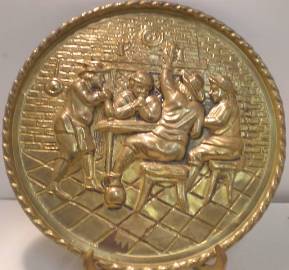
Leave a Reply